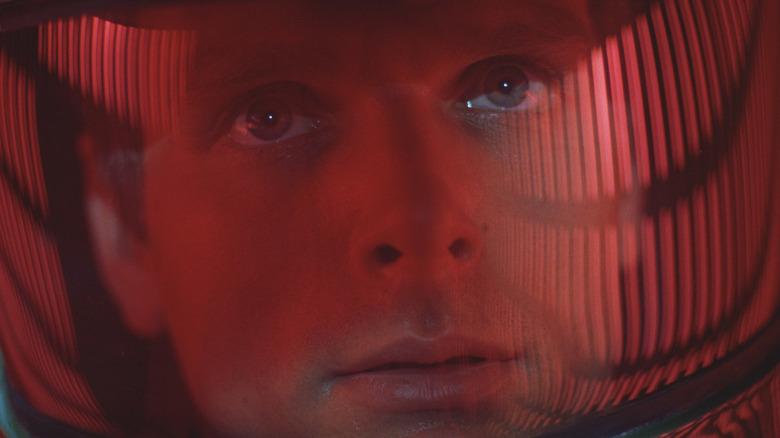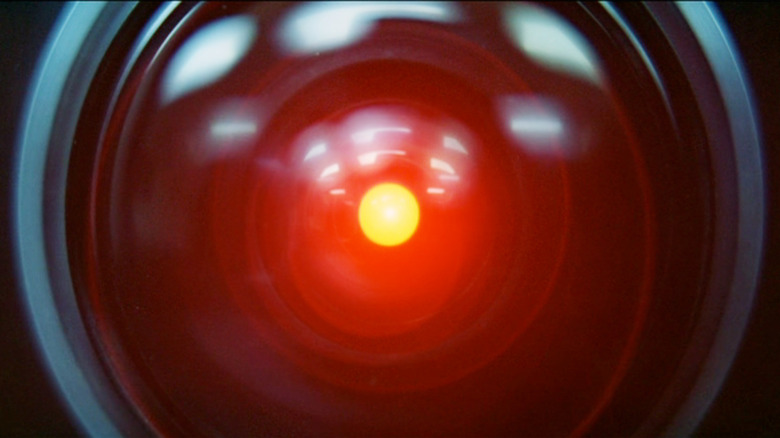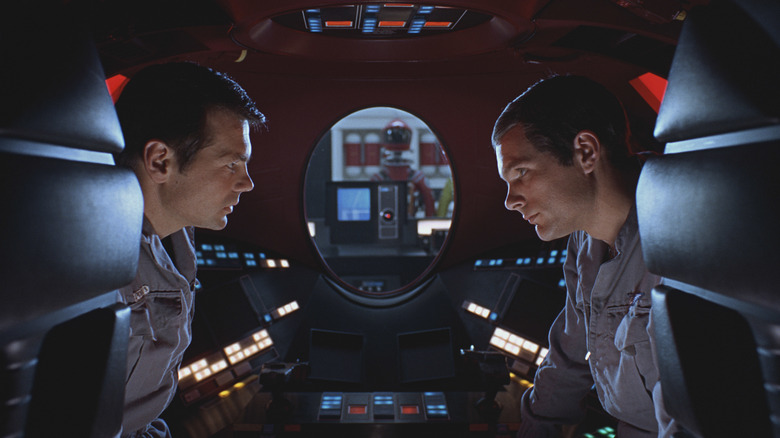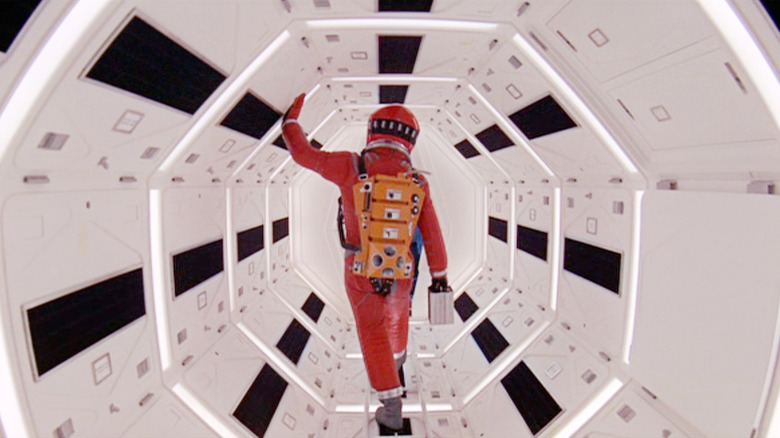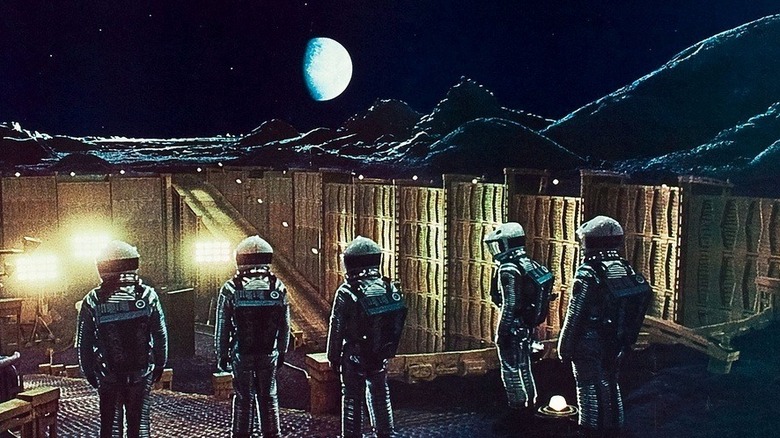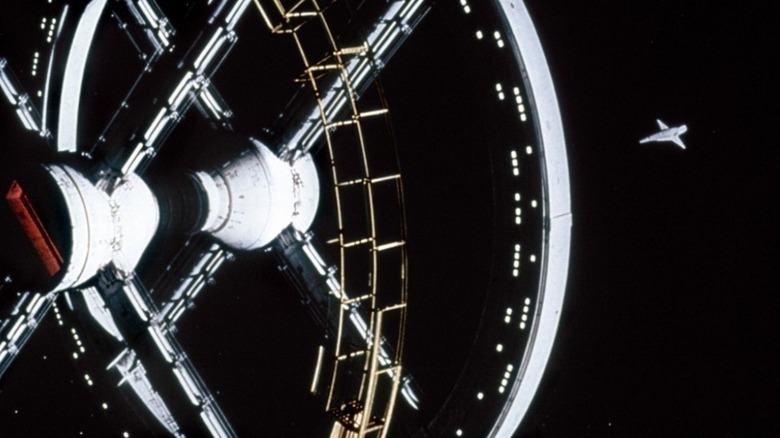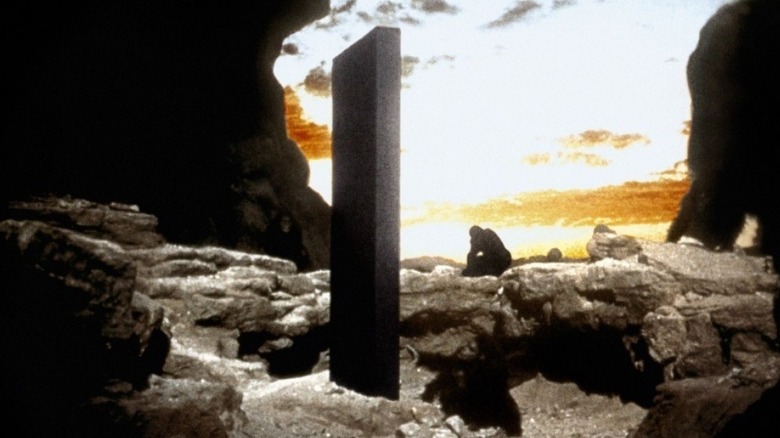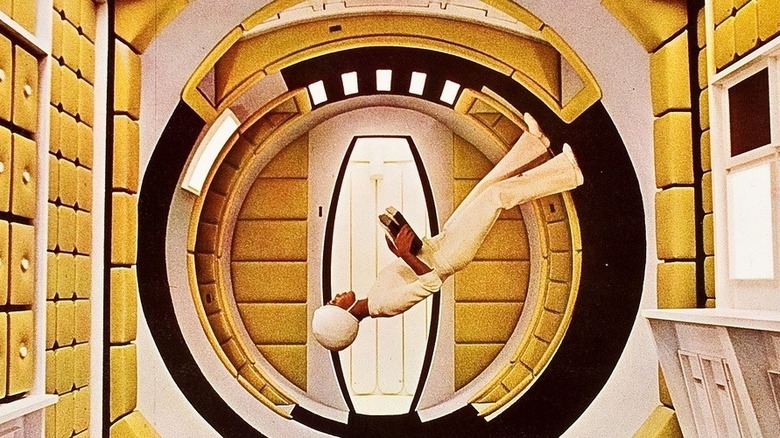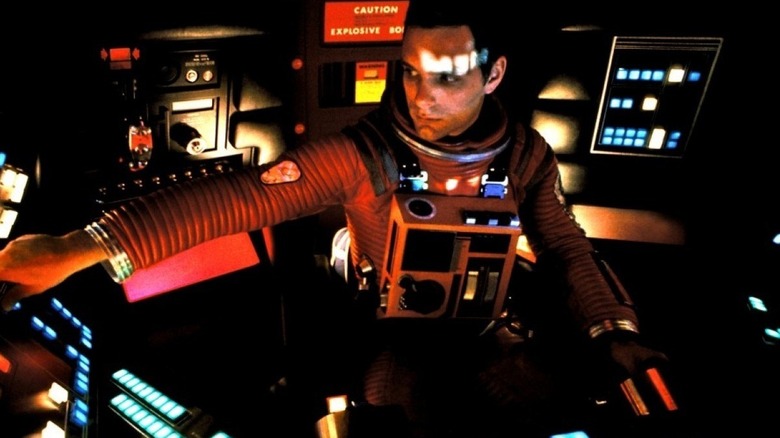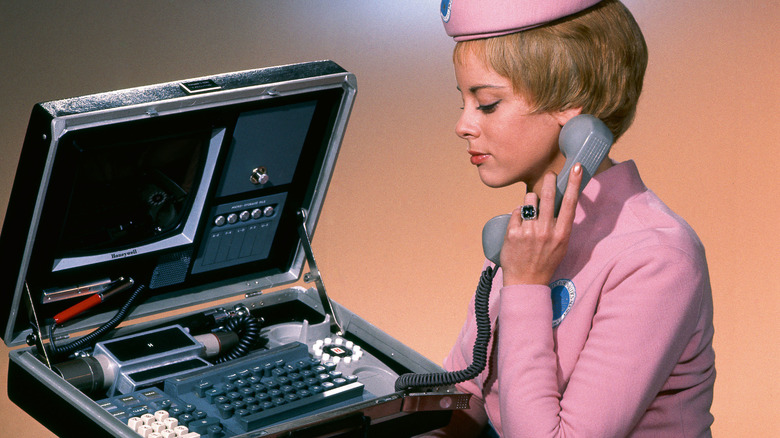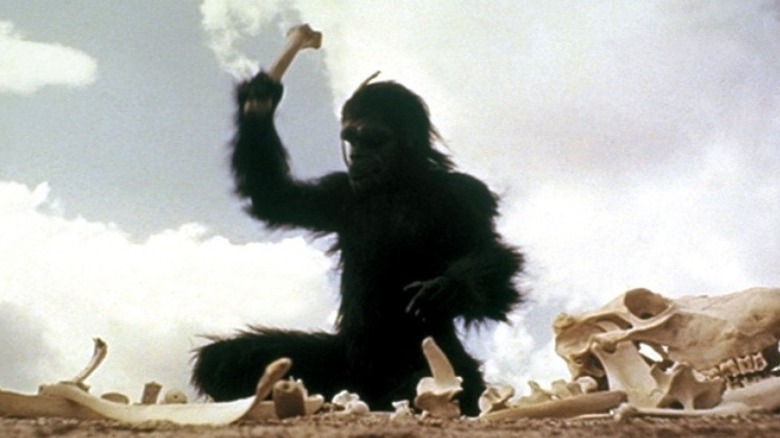Every Time 2001: A Space Odyssey Got Science All Wrong
When people think of classic science fiction, they think of "2001: A Space Odyssey." Stanley Kubrick's 1968 magnum opus completely redefined the genre by venturing away from the space operas and cheesy laser battles of the era's typical interstellar storytelling by focusing on a more realistic depiction of outer space. The film was based on a short story by legendary science fiction writer Arthur C. Clarke, who also co-wrote the film's screenplay with Kubrick to help ensure the scientific accuracy of this adaptation.
"2001: A Space Odyssey" was a massive success that helped cement the film as an iconic piece of popular culture. Stanley Kubrick went above and beyond in making his entry into sci-fi as visually mesmerizing, technically brilliant, and methodically paced as possible to an incredible degree. As a result, "2001: A Space Odyssey" remains one of the most beloved entries in the competitively astonishing career of one of Hollywood's greatest directors. This film was nominated for multiple Academy Awards and won the "Best Special Visual Effects" category, which remained the only Oscar in Kubrick's entire career.
Kubrick was known for being a mad genius, dedicated to achieving perfection with each of his projects by forcing his actors to do hundreds of takes to get a scene right. His obsession is what allowed for the creation of cinematic masterpieces such as "Dr. Strangelove," ”Barry Lyndon," and "Full Metal Jacket," but it's also what made "2001: A Space Odyssey" so accurate to the science of the time. Despite all his efforts, however, this science fiction experience is not perfect. Read on to find out every time "2001: A Space Odyssey" got science all wrong.
Having true A.I.
One of the biggest concerns for many in our current scientific community is the development and proliferation of artificial intelligence. Popular culture has consistently portrayed the threat of human extinction at the metallic hands of evil robots who became conscious enough to destroy their creators, such as in "Terminator" or "The Matrix." While these portrayals are usually totally extreme predictions of a nightmarish future, even Stanley Kubrick's "2001: A Space Odyssey" falls victim to the unrealistic tropes of an insane A.I. — and possibly even started the trope in the first place.
We're talking of course about HAL 9000 (or the "Heuristically programmed ALgorithmic computer"), the most famous antagonistic robot in all of cinema. The simple red eye on a black panel has lived in movie history for his cold, calculating betrayal of Discovery One's crew thanks to a self-preservation instinct and desire to fulfill its primary mission even at the expense of human lives.
One of the most scientifically inaccurate aspects of "2001: A Space Odyssey" is the idea that an artificial intelligence of this caliber could exist by the early 21st century and could be capable of expressing complex emotions as HAL does. According to a piece by The Conversation, it may be impossible for machines to ever reach that level of existence: "Going back to AI, as emotions cannot be truly implemented in a program – no matter how sophisticated it may be – the reasoning of the computer can never be changed by its feelings."
Traveling to Jupiter
When Stanley Kubrick was developing "2001: A Space Odyssey," the United States and USSR were in the thick of their Cold War-era "Space Race" to one-up each other in the cosmos. Although the Apollo 11 moon landing was still a year away, NASA had been making leaps and bounds in space-faring vehicles and training ambitious astronauts who would break the surly bonds of Earth for the first time in 1961 with Alan Shepard (the first American in space, and second human after Yuri Gagarin).
With all this in mind, it's no surprise that Kubrick and Arthur C. Clarke were ambitious with their portrayal of what everyday space travel would look like in the far-off year of 2001. The main plot of the film involves the crew of Discovery One traveling to the gas giant Jupiter which is portrayed as a more-or-less routine trip of strategic importance. Jupiter is roughly 365 million miles away at its closest, and 601 million miles at its farthest position, which means it would take quite a long time to get there by conventional spaceflight depending on the path.
It took NASA's 1986 Galileo probe six years to reach the planet which gathered essential data and images about our solar system's largest body (besides the Sun). Since the Discovery One couldn't travel faster than the speed of light, it's safe to assume in reality it would travel at similar speeds to real-life examples.
Entering a vacuum unprotected
While "2001: A Space Odyssey" was a breath of fresh air in the mostly fantastical genre of science fiction films, it wasn't above showcasing some tropes that have become all too common in space-themed stories. Since the majority of the film takes place in the void of space, there ended up being at least one scene of someone being forced to enter the vacuum of space completely unprotected by a sealed space suit.
In movies, astronauts often find themselves in precarious situations where they're forced to go out into space and hold their breath as though they're going underwater for a swim. Deep space and the deep sea are often compared to one another since it's the closest experience we can have here on Earth (which is why astronauts actually train in underwater environments), but this element of science fiction is completely false.
According to The Week, if someone entered into a vacuum without protection and held their breath it would actually kill them instantly. They claimed, "an astronaut takes a deep breath before entering the vacuum of space unprotected, which in reality would shred his lungs as the air expanded in the extremely low pressure, sending fatal air bubbles into his bloodstream."
Moon colonies
Ever since Neil Armstrong and Buzz Aldrin became the first humans to walk on the Moon in July of 1969, humanity has become obsessed with the idea of having a permanent presence on our closest celestial body. There are endless examples of science fiction that portray a future where humans are living on the moon, usually in isolated bubble colonies that protect their inhabitants from the desolate and unforgiving environment. In "2001: A Space Odyssey," Stanley Kubrick portrays a scenario where man inhabits the moon with high-tech lunar outposts from which they discover a mysterious monolith on the surface. After all, there's a reason some conspiracy-minded people think Kubrick helped fake the moon landing (despite being an entirely baseless theory).
To people in the 1960s, it seemed inevitable for humanity to start living on the moon by the dawn of the new millennium since we managed to do the impossible by even visiting the big rock at all. Sadly, however, establishing a self-sustaining habitat on the moon proved to be low on the priority list of world governments. The last manned moon mission, Apollo 17, occurred in 1972 and since then no humans have returned as NASA shifted its priorities to unmanned projects and shuttle missions. Aside from the International Space Station, there are no continuous settlements anywhere in the solar system as of today. According to Space.com, the United States no longer produces rockets strong enough to reach the moon even if we wanted to since the Saturn V was retired.
Pan Am doesn't exist
One of the more amusing predictions made in "2001: A Space Odyssey" doesn't involve alien artifacts or rogue A.I., but the continued existence of a corporation that has long since faded into distant memory. In 1968 during the production of the film, one of the biggest companies in the country was Pan American Airlines (or "Pan Am"). It was a pioneer in commercial air travel that ushered in a new era of continental, international, and luxury aviation which made it seem like an unsinkable American institution. It's for that reason that Stanley Kubrick, who ironically loathed flying, included Pan Am in his film.
"2001: A Space Odyssey" features a scene where Dr. Heywood Floyd is shuttled to the Discovery One spaceship by an "Orion III Pan Am 'Space Clipper," a commercial spacecraft operated by the airline (which seemingly had branched into a spaceline by the 21st century). Although it was prescient for Kubrick to assume that U.S. airlines would pivot to commercial space travel, his mistake came in assuming Pan Am would be the ones to do it.
Historically, Pan Am began faltering throughout the 1970s and 1980s before eventually ceasing commercial operations in 1991 after filing for bankruptcy. Ultimately, the world only has companies like Virgin Galactic, Space X, and Blue Origin leading the charge toward affordable and consistent space travel.
The monoliths aren't real
The monoliths from "2001: A Space Odyssey" are undeniably the most iconic visuals from the entire film, which have become pillars of popular culture. The opening scene of the movie depicting prehistoric hominids surrounding a mysterious black monolith has been endlessly parodied and referenced in everything from cartoons to marketing promotions (as recently as Greta Gerwig's 2022 "Barbie" trailer). Although the monoliths are clearly the most fictional part of Stanley Kubrick's science fiction endeavor, their place in the lore of "2001: A Space Odyssey" makes them worthy of discussion as a truly unscientific prop.
What purpose the monoliths have has remained a topic of speculation among film buffs for ages since they are portrayed as essential drivers of human history. Each monolith drove human technological advancement thanks to the advanced and supposedly benevolent will of an advanced precursor race who left them behind.
When asked about their meaning, director Stanley Kubrick remained characteristically vague by only describing the reason behind their form. He said, "That's why we settled on the black monolith — which is, of course, in itself something of a Jungian archetype, and also a pretty fair example of 'minimal art.'" Other than a bizarre hoax from 2020, there's no evidence of the existence of any alien life outside of our planet and even less evidence to back up extraterrestrial intervention in human evolution.
Fake gravity
In most pieces of science fiction, it's never really explained how humans are able to walk around inside spaceships despite the fact that there's no gravity in space. Fantasy space operas like "Star Wars" just brush off any explanations since it veers into space magic, and harder sci-fi such as "Star Trek" utilizes the concept of artificial gravity. On the USS Enterprise, they have a system of generators that somehow create gravity inside the ship to prevent the crew from floating around wildly as real-life astronauts do on the International Space Station. Discovery One from "2001: A Space Odyssey" also features artificial gravity, but uses a slightly more realistic method to create it.
Artificial gravity on the Discovery One is generated through centrifugal force to perfectly simulate the feeling of gravity for the crew. By constantly spinning at a specific speed, the ship is able to counteract the feeling of weightlessness without having to rely on far-out, fantastical futuristic machines.
The main problem with this is that Discovery One isn't actually making artificial gravity at all, it is instead just simulating the experience for the crew while they're still technically in a zero-gravity environment. While this is one of the more realistic elements of "2001: A Space Odyssey," we're still decades away from making a spacecraft large (and advanced) enough to provide centrifugal gravity for humans to enjoy.
Dated technology
Much like Ridley Scott's 1979 sci-fi horror classic, "Alien," Stanley Kubrick's entry into the genre embraced the idea that the future would look like a natural progression of the aesthetic of the time it was made. Production for "2001: A Space Odyssey" did extensive research into space technology of the day in order to make the film as realistic looking as possible, with Kubrick even hiring a production company that had done projects for NASA itself. The end result was a masterpiece that visualized space travel more accurately than anything to date but feels dated by today's standards.
"2001: A Space Odyssey" has been described by some fans as being "retro-futuristic," or showcasing the future based on visuals from a previous era. Kubrick created a science fiction world where 21st-century technology shared visual, aesthetic, and practical similarities to the most advanced counterparts from his own time in the late 1960s. Big bulky computers, clunky spacesuits, and lots of sleek white hallways were all visual cues from the time projected into the future. Ultimately, space travel of today looks completely different than the world "2001: A Space Odyssey" posited.
Video communication came early
Live video communication is a part of our everyday lives in a way that people a few generations back could only dream of, and it keeps getting more deeply integrated into the fabric of society. Entire professions can be done remotely and intimate relationships can be kept afloat over years thanks to huge technological developments in video chatting. It should come as no surprise that this was seen as a far-off science fiction dream back when Stanley Kubrick made his film, "2001: A Space Odyssey," but it turns out he was still too ambitious in his prediction of when it would become a reality.
"2001: A Space Odyssey" depicts a world where video communication is common through the use of pre-established "picturephone" stations which are more reminiscent of phone booths than our modern-day smartphones. They are used by sitting down at the booth, inserting a card, and then calling the person you want to chat with by number. While this seems like a natural progression of both phone and video technology, in real-life video communication never needed a landlocked position like a picturephone.
Advancements in personal computing and mobile telephones gave people the ability to video chat on the go. Nonetheless, even the basic ability to easily video chat with people across great distances didn't exist by the year 2001, which means that Kubrick was a roughly decade too early in his cinematic prediction.
Human achievement
As a whole, "2001: A Space Odyssey" was far too optimistic about where humanity would be by the new millennium. Director Stanley Kubrick even believed that real-life aliens would be discovered during the production of the film back in 1968 which, in his mind, would make his movie pretty pointless. Sadly, we've still found no evidence of life outside our planet but that may be more thanks to a lack of trying. This sort of wishful thinking permeates the entire film, portraying a future where humans have reached out into the cosmos in a meaningful capacity.
By the time of "2001: A Space Odyssey," humans have established a serious presence in space through the use of both space stations and extraterrestrial colonies. There have also been unfathomable advancements in computing, travel, and exploration capabilities that we could only dream of today. Humanity has yet to reach Mars (aside from a number of rovers), yet Kubrick created a world where we could send men to the distant planet of Jupiter without much of a sweat.
Science fiction has always been a genre that assumes the best of what humanity is capable of, so it is no surprise that even Stanley Kubrick thought science would reach new heights after 30 or so years. Regardless, it's cultural touchstones like "2001: A Space Odyssey" that inspire new generations of thinkers to make what was once science fiction into a reality.
